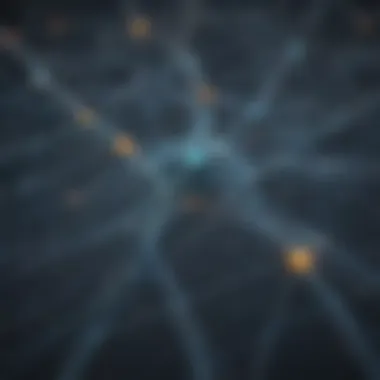Mastering Neural Networks: A Comprehensive Guide to Advanced Proficiency


Overview of Neural Networks in Software Development
In the realm of software development, neural networks serve as a fundamental component of cutting-edge technology. Their importance lies in their ability to mimic the human brain's functioning, enabling machines to learn from data, make decisions, and perform tasks with remarkable efficiency. Key features include artificial neurons, layers, weights, and activation functions. These features allow neural networks to perform complex tasks such as image recognition, natural language processing, and predictive analytics. Use cases range from self-driving cars to medical diagnostics, financial forecasting, and personalized recommendations.
Best Practices for Mastering Neural Networks
Industry best practices for mastering neural networks involve a deep understanding of neural network architectures, training algorithms, and hyperparameter tuning. To maximize efficiency and productivity, practitioners should experiment with different network structures, regularization techniques, and optimization algorithms. Common pitfalls to avoid include overfitting, vanishing gradients, and insufficient data preprocessing. By following best practices, individuals can enhance their neural network proficiency and achieve optimal performance in various applications.
Case Studies of Neural Network Implementations
Real-world case studies highlight successful implementations of neural networks across diverse industries. These case studies showcase the transformative impact of neural networks in healthcare, finance, marketing, and more. Lessons learned include the importance of data quality, model interpretability, and regulatory compliance. Insights from industry experts underscore the increasing adoption of neural networks to revolutionize business processes, drive innovation, and gain a competitive edge in the digital landscape.
Latest Trends and Updates in Neural Networks
Ongoing advancements in neural networks encompass developments in deep learning, reinforcement learning, and explainable AI. Current industry trends focus on scalable deep learning frameworks, automated machine learning tools, and ethical AI practices. Innovations such as GANs, Transformers, and Capsule Networks are shaping the future of neural network technology. Forecasts predict continued growth in AI applications, autonomous systems, and human-AI collaboration, indicating a dynamic landscape of opportunities and challenges.
How-To Guides and Tutorials for Neural Network Mastery
Step-by-step guides offer practical insights for beginners and advanced users looking to master neural networks. These tutorials cover topics like building a neural network from scratch, fine-tuning pre-trained models, and deploying models in production environments. Practical tips and tricks include data augmentation, transfer learning, and model interpretation techniques. By following these guides, individuals can gain hands-on experience and develop proficiency in developing and deploying neural network solutions.
Introduction to Neural Networks
In this specific segment on the introduction to neural networks, we delve into the foundational aspects that form the basis of this multifaceted technology. Understanding the core principles behind neural networks is paramount for anyone looking to navigate the realms of artificial intelligence and machine learning. By comprehending how neural networks mimic the human brain's structure and function through interconnected layers of neurons, individuals can grasp the power and potential these systems offer. Exploring the intricacies of neurons, synapses, basic architecture, and activation functions sets the stage for a profound comprehension of neural networks' inner workings.
Understanding Neural Networks
Neurons and Synapses
Neurons and synapses are the building blocks of neural networks, mirroring the biological counterparts present in the brain. Neurons function as computational units, processing and transmitting information through synaptic connections. The vital characteristic of neurons lies in their ability to adapt and learn from input data, making them a crucial element in the neural network architecture. Despite their complexity, neurons offer unparalleled parallel processing efficiency, enabling neural networks to perform complex tasks with remarkable speed and accuracy.
Basic Architecture
The basic architecture of a neural network encompasses the arrangement and connectivity pattern of layers and neurons within the system. This pivotal structure determines how information flows through the network, impacting learning capabilities and overall performance. The key feature of basic architecture is its scalability and flexibility, allowing for the construction of neural networks tailored to specific tasks and datasets. While offering adaptability and robustness, the basic architecture of neural networks also presents challenges in terms of computational resources and training efficiency.
Activation Functions


Activation functions play a crucial role in neural networks by introducing non-linearities to the system, enabling complex relationships to be captured during training. The primary characteristic of activation functions is their ability to introduce non-linear transformations to the input data, facilitating the network's ability to learn from intricate patterns and nuances. Despite their significance in enhancing model expressiveness, the choice of activation function impacts training convergence and computational efficiency. Understanding the unique features and nuances of activation functions is essential for optimizing neural network performance and achieving desired learning outcomes.
Foundations of Learning Neural Networks
Foundations of Learning Neural Networks plays a pivotal role in this article, serving as the bedrock upon which neural network proficiency is built. It encompasses crucial elements such as Data Preparation and Model Training, which are essential for building robust and accurate neural network models. Data Preparation involves processes like Data Cleaning, Feature Engineering, and Normalization, which are indispensable for ensuring the quality and reliability of data fed into the neural network. Model Training, on the other hand, focuses on fine-tuning the neural network architecture through Optimization Algorithms, Hyperparameter Tuning, and Regularization Techniques, optimizing the model's performance and efficacy. Understanding these foundational concepts is imperative for individuals seeking to master neural networks, as they lay the groundwork for advanced techniques and applications.
Data Preparation
Data Cleaning
Data Cleaning is a critical aspect of Data Preparation that involves identifying and handling errors, inconsistencies, and missing values in the dataset. By cleaning the data, noise is reduced, and the overall quality of the dataset is improved, leading to more accurate model predictions. Data Cleaning is essential for this article as it ensures that the neural network trains on reliable and consistent data, minimizing the risk of bias or inaccurate outcomes. While time-consuming, Data Cleaning is a necessary step in the data preprocessing pipeline, ultimately contributing to the model's overall performance.
Feature Engineering
Feature Engineering focuses on selecting, modifying, or creating new features from the existing dataset to enhance the model's predictive power. It plays a vital role in this article by transforming raw data into a format that the neural network can effectively learn from. Feature Engineering aims to highlight important patterns and relationships within the data, enabling the model to make better decisions and predictions. Despite its complexity, Feature Engineering is a popular choice for enhancing model performance and is a key factor in maximizing neural network efficiency.
Normalization
Normalization is a technique that scales and standardizes the numerical features of the dataset, bringing them within a specific range to facilitate the training process. It is crucial for this article as it ensures that all input features contribute equally to the model, preventing any particular feature from dominating the training process. Normalization helps in speeding up the model convergence and improving its stability during training. While it has clear advantages in enhancing neural network performance, improper normalization strategies can lead to unintended consequences, highlighting the importance of using this technique judiciously.
Advanced Techniques in Neural Networks
In the realm of neural networks, mastering advanced techniques is imperative to push the boundaries of artificial intelligence. This section explores pivotal methodologies that elevate neural network performance to new heights. By delving into advanced techniques, practitioners can enhance model efficiency, accuracy, and versatility. These techniques serve as a gateway to optimizing neural networks for complex tasks and datasets, laying a solid foundation for cutting-edge applications.
Transfer Learning
Fine-Tuning Pretrained Models
Fine-tuning pretrained models stands out as a remarkable approach in neural network development. This strategy involves taking a pre-existing model that excels in a similar task and fine-tuning its parameters to adapt to a new, related task. The key advantage of fine-tuning lies in leveraging the learned features of the pretrained model, allowing for quicker convergence and requiring less data for training. This method proves to be a popular choice in this comprehensive guide due to its efficiency in optimizing neural network performance without starting from scratch. However, one must be cautious of overfitting when fine-tuning, as the model could excessively adapt to the original dataset, leading to decreased generalization.
Domain Adaptation
Domain adaptation plays a crucial role in addressing the challenge of model deployment across different domains. This technique focuses on adapting a model trained on a specific domain to perform effectively in a new, unseen domain. By emphasizing domain-invariant features during training, domain adaptation enables neural networks to generalize better to diverse data distributions. Its significance in this article lies in bridging the domain gap and enhancing model robustness across varying scenarios. Despite its advantages, domain adaptation may face limitations in scenarios with significant domain shift, requiring intricate adjustments to achieve optimal performance.
Knowledge Distillation


Knowledge distillation introduces a method of compressing knowledge from a larger, complex model (teacher) into a smaller, more efficient model (student). By transferring knowledge representations and decision-making logic from the teacher model to the student, knowledge distillation enables the creation of compact yet powerful neural networks. This technique proves beneficial in this guide by enabling the deployment of lightweight models with comparable performance to larger counterparts, facilitating efficient inference on resource-constrained devices. However, knowledge distillation may lead to a loss of intricacies present in the teacher model, impacting the student model's overall accuracy.
Generative Adversarial Networks (GANs)
GAN Architecture
The architecture of generative adversarial networks (GANs) revolutionizes the field of generative modeling by introducing a framework where a generator and a discriminator compete in a min-max game to enhance generated outputs. This unique setup fosters the creation of highly realistic synthetic data, valuable for tasks such as image generation and data augmentation. The robustness and creativity enabled by GAN architecture position it as a valuable inclusion in this article, offering insights into the dynamic interplay between generator and discriminator for effective generative model training. However, GANs may face challenges such as mode collapse, where the generator fails to capture the full data distribution.
Training GANs
The training process of GANs involves optimizing the generator and discriminator iteratively to achieve equilibrium. Training GANs requires meticulous tuning of hyperparameters, careful selection of loss functions, and strategies to prevent mode collapse or vanishing gradients. This section is crucial in the comprehensive guide as it delves into the nuances of training GANs effectively to generate high-quality samples. Despite the power of GANs in generating diverse data distributions, training instability and mode dropping pose significant challenges that practitioners must navigate for successful model convergence.
Applications of GANs
The applications of GANs span a wide array of domains, including image synthesis, style transfer, and data anonymization. By harnessing the generative capabilities of GANs, researchers and practitioners can create realistic images, manipulate visual styles, and generate synthetic data for privacy-preserving tasks. This subsection elucidates the versatile applications of GANs in enhancing neural network performance, shedding light on the potential for leveraging generated data for training robust models. Despite their utility, GANs may encounter difficulties in training convergence and mode collapse that impact the quality of generated samples.
Optimizing Neural Networks Performance
Optimizing Neural Networks Performance is a pivotal aspect of mastering neural networks explored extensively in this comprehensive guide. Enhancing the performance of neural networks is crucial for achieving accurate results and efficient model predictions. By optimizing neural networks effectively, one can improve model accuracy, reduce computational resources, and enhance overall model efficiency. Various techniques such as fine-tuning hyperparameters, selecting appropriate activation functions, and implementing regularization methods play a vital role in optimizing neural networks performance.
Performance Metrics
Accuracy:
Accuracy, a fundamental performance metric, measures the percentage of correctly predicted instances by the model out of the total instances. In the context of neural networks, accuracy indicates the model's effectiveness in making correct predictions. High accuracy is desired to ensure the model's reliability and precision. However, accuracy alone may not be sufficient to evaluate model performance, especially in scenarios with imbalanced datasets where accuracy can be misleading. Despite its significance, accuracy should be interpreted alongside other performance metrics for a comprehensive evaluation.
Precision and Recall:
Precision and Recall are essential metrics in evaluating the performance of classification models. Precision refers to the ability of the model to correctly identify relevant instances among the predicted positives. Conversely, recall measures the model's capability to identify all relevant instances among the actual positives. Balancing precision and recall is crucial, as an increase in one may lead to a decrease in the other. Optimizing neural networks performance involves enhancing both precision and recall to ensure a robust and reliable model.
F1 Score:
The F1 Score, a composite metric of precision and recall, provides a harmonic mean of these two metrics. F1 Score considers both false positives and false negatives, offering a balanced evaluation of the model's performance. A higher F1 Score indicates a model that has both high precision and recall, making it a suitable metric for situations where achieving a balance between precision and recall is crucial. It is imperative to consider the F1 Score along with other performance metrics to gain a comprehensive understanding of the model's performance.
Model Evaluation


Cross-Validation:
Cross-validation is a technique used to assess a model's generalization performance by splitting the dataset into multiple subsets for training and validation. It helps in estimating how the model will perform on unseen data and prevents overfitting. By validating the model across different subsets of data, cross-validation provides a robust evaluation of the model's performance and ensures its reliability in diverse scenarios.
Confusion Matrix:
The confusion matrix is a tabular representation that allows for a detailed analysis of a model's performance in classification tasks. It provides insights into true positive, true negative, false positive, and false negative predictions made by the model. Analyzing the confusion matrix helps in identifying where the model excels and where improvements are required. It serves as a valuable tool for evaluating the effectiveness of a neural network model and guiding optimization strategies.
ROC Curves:
ROC (Receiver Operating Characteristic) Curves visualize the trade-off between true positive rate and false positive rate across different threshold values. The area under the ROC curve (AUC) quantifies the model's ability to distinguish between classes. ROC curves are especially useful for evaluating the performance of binary classification models and determining the optimal threshold for decision-making. By analyzing ROC curves, one can assess the model's predictive power and make informed decisions regarding model optimization strategies.
Challenges and Pitfalls in Learning Neural Networks
In the realm of neural networks, understanding and navigating the challenges and pitfalls that may arise are paramount for ensuring the success of any AI-related project. The intricacies of neural network training cycles can often lead to issues such as overfitting, underfitting, and other complexities that culminate in suboptimal model performance. Hence, this section focuses on elucidating these obstacles and offering strategies to overcome them, ensuring that readers are equipped with the knowledge to troubleshoot effectively.
Overfitting and Underfitting
Regularization Techniques
Regularization techniques play a pivotal role in mitigating the effects of overfitting, a phenomenon where the model performs exceptionally well on training data but falters when faced with new, unseen data. By introducing penalties or constraints on the model's complexity, regularization techniques like L1 and L2 regularization help prevent overfitting, promoting generalization and robustness. Their ability to strike a balance between variance and bias is instrumental in enhancing model performance, making them indispensable tools in a data scientist's repertoire.
Early Stopping
Early stopping emerges as a key strategy to combat overfitting by monitoring the model's performance during training and halting the process once the validation error ceases to improve. This proactive approach prevents the model from memorizing noise in the training data, thereby enhancing its ability to make accurate predictions on unseen data. As a popular technique in neural network training, early stopping contributes significantly to improving model efficiency and generalization.
Data Augmentation
Data augmentation stands out as a powerful technique to tackle the limitations of underfitting, where the model fails to capture the underlying patterns in the data. By artificially increasing the diversity and volume of training data through transformations like rotation, scaling, and flipping, data augmentation enriches the model's learning process, enabling it to grasp intricate patterns and nuances better. The versatility and effectiveness of data augmentation make it a go-to approach for addressing underfitting issues, instilling resilience and adaptability in neural network models.
Vanishing and Exploding Gradients
Gradient Clipping
Gradient clipping addresses the challenge of vanishing and exploding gradients, a common issue encountered during the training of deep neural networks. By limiting the magnitude of gradients during backpropagation, gradient clipping ensures stable and consistent learning, preventing drastic oscillations that hinder convergence. This technique fosters smoother optimization trajectories, facilitating quicker convergence and overall model stability, making it an indispensable tool in optimizing neural network performance.
Batch Normalization
Batch normalization aids in combating vanishing and exploding gradients by normalizing the input to each layer across mini-batches, reducing internal covariate shift and accelerating convergence. By improving the flow of gradients and enhancing the stability of deep networks, batch normalization streamlines the training process, enabling smoother and more efficient optimization. Its ability to expedite training, improve generalization, and mitigate the impact of gradient-related challenges cements batch normalization as a fundamental technique in the neural network optimization arsenal.
Residual Connections
Residual connections offer a unique mechanism to address the degradation problem in extremely deep neural networks, where adding more layers may hinder performance rather than improve it. By introducing skip connections that bypass certain layers, residual connections allow for easier optimization and training of deep networks, facilitating the flow of gradients and easing the learning process. This innovative approach not only enhances gradient flow and speeds up convergence but also enables the training of ultra-deep architectures with greater ease and efficiency, making residual connections a valuable asset in neural network optimization.



